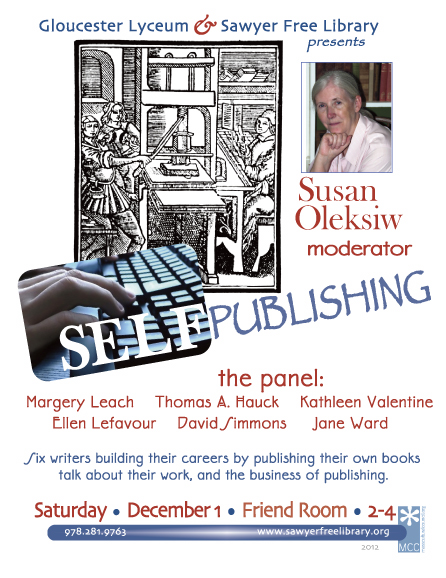The Self-publishing Event at the Sawyer Free was packed. Ironically, when the program was held two years ago, moderator Susan Oleksiw said that there were more people in the panel than in attendance, which speaks to the overall dismal state of traditional publishing houses versus the growth of the self-publishing industry. Susan did a great job moderating and each panelist brought to the discussion a different approach based on their individual experiences with self publishing. The sheer range of options is fascinating and anyone facing the challenges of self-publishing would be well served to thoroughly research all.
Tag: Self publishing
Self-publishing Event at the Sawyer Free Library
Part 3 What is “Self” Publishing? From Kat Valentine– Before You Go To Press
Here is part 3. It is a little longer but I cannot emphasize the part in yellow enough! Thank so much!!!
Spelling and Grammar Matter
Thanks to the internet more people than ever are writing on a daily basis – they are blogging, Twittering, Facebooking, IMing, emailing, texting, etc. etc. However, all this writing has lead to a decline in basic grammar and spelling. This may be fine for everyday communications but that does not make it fine for books. Spell check will find words which are spelled incorrectly but it will not differentiate between there/their/they’re, point out words that are used incorrectly, correct punctuation, etc. There are also grammatical conventions for constructing things such as dialog that should be followed if you want your published work to look professional.
Authors who are not open to having their manuscripts proofed, edited, and critiqued should really consider whether they are serious about publishing. Professionals in the publishing business tell me that if an author resists editing and making changes they cannot work with them and will terminate the contract. While it is perfectly reasonable to resist significant content changes to a book (one of my agents wanted me to rewrite The Old Mermaid’s Tale for the Young Adult market — I refused), writers have to comply with standard grammar, punctuation, structure, etc. if they want to be taken seriously.
COMMIT TO QUALITY
Please remember this: when you publish a badly written, badly proofed,
badly edited book, you don’t just make yourself look bad,
you make all self-published authors look bad.
Readers are becoming increasingly sensitive to self-publishing and have no reticence
to give very bad reviews to badly constructed books.
As a self-publisher commit to the highest standards possible.
Preparing Files: Print Publishing vs. ePublishing
Remember: printed material is made of ink, electronic material is made of light.
Continued at: http://parlezmoiblog.blogspot.com/2011/01/part-3-before-you-go-to-press.html
Part 2 continued – What is “Self” Publishing? From Kat Valentine
What is INDEPENDENT PUBLISHING & how is it different from subsidy publishing?
Unlike subsidy publishing, independent publishing is entirely controlled by the author. Most of the prominent writers who have self-published have done so independently so that they could publish under their own imprint. What this means is that they take control of the entire process which includes selecting a name for their publishing company (I use Parlez-Moi Press) and purchasing their ISBNs under that imprint so their books are published by their own imprint. Sometimes 3 or 4 authors work together to form a small press, one local example is Back Shore Press which was formed by Peter Anastas, Schuyler Hoffman, and Peter Tuttle to publish and promote their books.
This is how an independent publisher publishes:
-
Editing and Proofing: No matter how skillful you are and no matter how much effort you put into your work it will need proofing. Mistakes occur even in books by major publishers.
Continued at http://parlezmoiblog.blogspot.com/p/publishing-your-book-today.html
Part 2 – What is “Self” Publishing? From Kat Valentine
I keep telling Kat she should write is “How To Publish/Or Not Publish For Dummies”
EVERYBODY has a story to tell. EVERYBODY thinks they are interesting. Hardly anyone knows the ins and outs of the industry like Kat does.
Kat Writes-
Subsidy Publishing vs. Independent Publishing
For many people the words “self-published” bear a stigma and the suggestion that self-publishing is the only option the author had to get a book in to print. This is not true. Some authors who have self-published are Mark Twain, John Grisham, Tom Clancy, Deepak Chopra, Virginia Woolf, and Margaret Atwood. Among the most famous of self-published books are Huckleberry Finn, the Chicken Soup for the Soul books, and that most ubiquitous cookbook, The Joy of Cooking. Authors self publish for a variety of reasons.
Today publishing has been complicated by the addition of e-publishing. In this post I’m going to discuss the different types of print publishing, and include information on how e-books are handled by each. Since we already talked about traditional publishing I won’t delve much further in to that but bear these things in mind as you decide how much time and effort you wish to spend pursuing a contract with a traditional publisher:
Continued at: http://parlezmoiblog.blogspot.com/p/publishing-your-book-today.html
How To Publish Your Book (or Not) From Kat Valentine
With the explosion in eBook readers such as the Kindle, Nook and iPad I‘ve been intrigued on how things in the publishing world are changing. Katy Valentine has a good number of books in print and also available electronically. Not only that, Kat has helped local authors self publish their own books like Melissa Abbott. So to say that Kat can speak to the subject would be an understatement.
So Kat is doing a series on her blog-Parlez-Moi Press about the different ways that people go about bringing their books to the marketplace and she is Guest posting here on GMG.
So here is the first in her series-
How To Publish Your Book (or Not)
Innovations in digital technology mean that publishing today is very different than it was even a few years ago. Also the growth and popularity of ebooks has changed the entire industry. In December 2010 Barnes & Noble announced that their web site sold more ebooks than print books. This trend is just beginning.
Since I have five books currently in paperback and six ebooks (plus 2 in production) I have learned a lot about the publishing industry. In 2010 I sold a little over a thousand books in a combination of paperback and eformat. Along the way I’ve learned a lot about publishing and I am writing this to provide information for other authors who wish to publish. What I write here is purely from my own experience and I will be adding to this as time permits in the hope it will help. So let me begin with a few words about conventional publishing:
Part 1 – Conventional Publishing & How It Works
The ideal for most aspiring authors is to sell their manuscript to a big publisher, get a hefty advance, and have their book edited, designed, printed and distributed. Once the book is in print authors dream of book signing tours set up and paid for by their publisher where they are wined and dined, meet their fans, sell and sign lots of books, and the money starts rolling in. The ultimate ideal is for the book to be optioned by Hollywood, a movie made with top name stars, and merchandising rights for everything from t-shirts to video games. This is a nice dream and it does happen for some lucky people but they are very much in the minority.
The truth is a publisher has to consider a lot of factors before even considering to publish a book, the top ones being a.) how much will they have to invest to produce it, and b.) how much market appeal does it have. Producing a book is very, very costly. The process of editing, working with the author through rewrites, designing, printing, distributing and promoting is expensive and publishers have to make sure their investment will yield a profit to justify their expenses. One of the things they need to consider is how marketable the author is, as well as the book. Like it or not, we live in a personality-driven society. New authors are tough to promote and an author who has a certain measure of “star” power has an advantage. Sad to say, but a lot of readers are more interested in the authors than in their books.
Continued at: http://parlezmoiblog.blogspot.com/p/publishing-your-book-today.html
Author Jane Ward Puts Ego Aside And Takes Matters Into Her Own Hands
Writer, Editor, Publisher…Me
By Jane Ward
The email to my agent is drafted. All I have to do is click the “send” button. Within seconds, she’ll see my decision:
I would like you to pull my food-memoir manuscript out of circulation, for now anyway, while I give serious consideration to the direction in which I want to take my nonfiction writing.
“As for the second manuscript of mine, the mainstream fiction manuscript that has been making the rounds for the past year, I would like that off the market as well. In fact, I would like all copies of that manuscript returned.
“I have decided to publish it myself.”
Self-publishing? Undertaking the roles of editor and publisher in addition to my primary role of writer, all for the pleasure of seeing my work in print?
"Farmers Market Cart," © Jane Ward
Thanks to print-on-demand technology, self-publishing in our digital world has progressed from the pay-to-play model of old. But the option still carries a bit of the vanity press stigma.
While I’m elated that there is a modern print alternative to traditional publishing houses, I have to ask myself about my motives. Is it vanity? Or is it something else?









